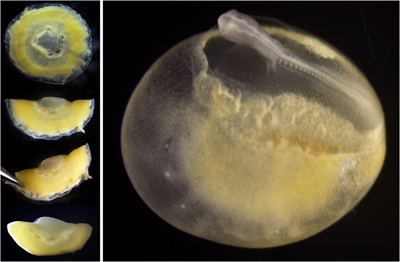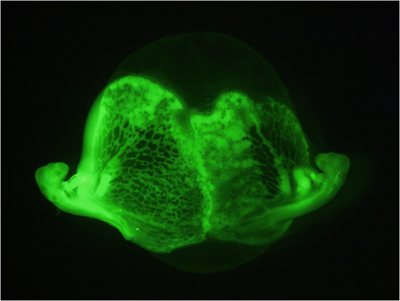| RIKEN Center for Developmental Biology (CDB) 2-2-3 Minatojima minamimachi, Chuo-ku, Kobe 650-0047, Japan |
January 4, 2011 –Birds, such as the chicken, provide an excellent model for the study of many developmental processes, and remain one of the most commonly studied species in classical embryology. The earliest stages of avian embryonic development are not amenable, however, to manipulation within the egg, necessitating methods for embryo culture. A number of techniques for sustaining the growth of chicken embryos ex ovo have been developed, but are limited by cumbersome set-up and relatively short survival times. Methodological advances might therefore expand the utility of ex ovo approaches and enable studies of later occurring developmental phenomena.
Hiroki Nagai and colleagues in the Laboratory for Early Embryogenesis (Guojun Sheng, Team Leader) have done just that with a new twist on ex ovo chick embryo culture, which they have christened the modified Cornish pasty (MC) method, as it is based on a previous technique that involves folding the explanted embryo in two, similar to the preparation of the well-known British pastry. The new method, described in the journal Genesis, is simpler to perform than its predecessors and sustains embryos to later stages of development. The protocol involves removing the embryo from the egg during the primitive streak phase of development, between stages 3 and 4 on the Hamburger- Hamilton (HH) scale, folding it along an axis parallel to the primitive streak so that it takes on a half-moon shape, and transferring it to culture medium. Interestingly, within 24 hours most of the embryos “inflate,” apparently due to active transport of fluid, and rise to the surface of the medium. This fluid transport is important, as it maintains epiblast tension, which is crucial for early development. The majority of embryos maintained under these conditions grew at normal rates for the first day of culture, but later slowed slightly relative to normal development. Importantly, about half of all MC cultured embryos survived with normal morphology until HH18, an advance over previous methods, which could only sustain growth until HH13-15. This survival gain is significant in that a number of features of vascular, head, and limb formation only begin to appear at around stage 18. In a number of the MC embryos, growth of the head region continued beyond HH18, although limb development was arrested, meaning that the new method might prove useful in ex ovo studies of even later stages of head development. To confirm that their new method could be used in complement with other manipulations, Nagai et al. tested several embryological techniques in the folded explants. They found that embryos electroporated with GFP grew normally and were stained as expected with fluorescent signals. They next tried a trickier experiment, known as parabiosis, in which a pair of embryos is co-cultured in close contact with each other, resulting in twin embryos with shared blood circulation. Using a slightly modified version of their new method, they found that they could generate parabiotic pairs of chicks, quails and even combinatorial parabiosis involving a chick-quail pairing. Such experimental systems are useful in the study of blood development.
“The chick is a wonderful model organism for developmental biology studies, but the modified Cornish pasty culture, or the dumpling culture as I like to call it, shows that we still don’t understand the embryo well, as no one would have predicted that twinning and parabiosis can be created this way,” says Sheng. “Our next goal is to use this technique to test some of the hypotheses regarding the origin of definitive hematopoietic stem cells. “
|
|||||||
|
|||||||
 |
| Copyright (C) CENTER FOR DEVELOPMENTAL BIOLOGY All rights reserved. |

